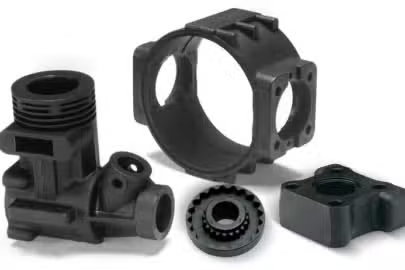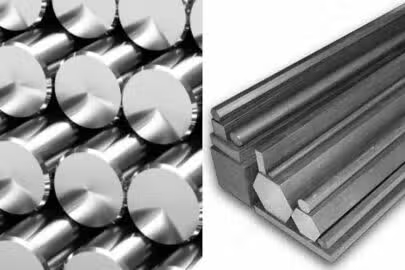Differentiating between ferrous and non-ferrous metals is essential for precision parts manufacturing, construction, or metalworking. Ferrous metals, characterized by their iron content, offer exceptional strength, durability, and magnetic properties, making them vital in heavy industries and infrastructure projects.
In contrast, non-ferrous metals, which do not contain iron, are valued for their lightweight, corrosion resistance, and superior electrical conductivity, making them ideal for aerospace, electronics, and plumbing applications. This article discusses the types and applications of ferrous and non-ferrous metals and compares them to help you choose the right material for your specific needs and ensure optimal performance and longevity in your projects.

What are Ferrous Metals?
Ferrous metals contain iron as their main component. These metals are known for their strength and durability, making them popular in construction, automotive, and manufacturing industries. The most common ferrous metals include steel, cast iron, and wrought iron. Steel, in particular, is an alloy of iron and carbon and is used extensively in building structures, bridges, and machinery due to its high tensile strength and hardness.
A distinctive feature of ferrous metals is their magnetic properties, crucial for various applications, such as motors and electrical appliances. This magnetic characteristic is mainly due to the iron content in these metals. However, one drawback of ferrous metals is their tendency to rust when exposed to moisture and oxygen. This susceptibility to corrosion arises because iron oxidizes, forming rust. To prevent this, ferrous metals often undergo protective treatments, such as galvanizing or painting, to enhance their resistance to environmental factors.
In addition to their mechanical properties, ferrous metals are also valued for their recyclability, which supports sustainable practices in industries that consume large quantities of raw materials. The combination of strength, magnetic properties, and recyclability makes ferrous metals worthwhile in various technological and industrial advancements.
What are Non-Ferrous Metals?

Non-ferrous metals are those that do not contain iron as a primary component. They are prized for their different properties, which include high resistance to corrosion, lightweight, and excellent conductivity. Examples of non-ferrous metals include aluminum, copper, lead, zinc, and precious metals like gold and silver.
One of the standout properties of non-ferrous metals is their rust and corrosion resistance, making them ideal for applications exposed to moisture and harsh environments. For instance, aluminum is extensively used in the aerospace and transportation industries due to its lightweight and high strength-to-weight ratio. Copper, known for its excellent electrical conductivity, is a critical material in electrical wiring and electronic components.
Non-ferrous metals are also characterized by their non-magnetic properties, which are essential for specific applications where magnetic interference needs to be avoided. These metals are often more malleable and ductile than ferrous metals, allowing them to be easily shaped and formed into various products.
Another significant advantage of non-ferrous metals is their recyclability. Metals like aluminum and copper can be recycled repeatedly without losing their properties, supporting sustainable practices and reducing environmental impact. The unique combination of corrosion resistance, conductivity, lightweight, and recyclability makes non-ferrous metals vital in various industries, including aerospace, electronics, construction, and renewable energy.
Types of Ferrous Metals
Ferrous metals encompass various materials, each with unique properties and applications. Here are the main types of ferrous metals:
Steel
Steel is an alloy made primarily of iron and carbon. It is one of the most widely used ferrous metals due to its high tensile strength, durability, and versatility. There are several types of steel, including:
- Carbon Steel contains varying amounts of carbon, which affects its hardness and strength. It is commonly used in construction and manufacturing.
- Stainless Steel contains chromium, which provides excellent corrosion resistance. It is used in kitchenware, medical instruments, and construction.
- Alloy Steel contains additional elements like nickel, vanadium, and tungsten to enhance specific properties. It is used in specialized applications like automotive parts and machinery.
Cast Iron
Cast iron is an alloy of iron, carbon, and silicon. It is known for its excellent castability, compressive strength, and wear resistance. Cast iron is commonly used in heavy-duty applications such as:
- Gray Cast Iron is characterized by its graphite flakes, which provide good machinability and wear resistance. It is used in engine blocks, pipes, and cookware.
- Ductile Iron contains small amounts of magnesium, which makes it more flexible and impact-resistant than gray cast iron. It is used in automotive components, pipes, and machinery.
Wrought Iron
Wrought iron is highly refined and has a very low carbon content, typically less than 0.08%. It is known for its ductility, malleability, and resistance to corrosion, making it ideal for decorative and architectural applications. Historically, wrought iron was produced through a labour-intensive process involving repeated heating and hammering to remove impurities, resulting in a material with a fibrous structure that enhances its strength and durability.
Tool Steel
Tool steel is a type of carbon and alloy steel known for its hardness, abrasion resistance, and ability to hold a cutting edge. It is used in the manufacturing of tools and dies. Commonly categorized into:
- High-speed steel (HSS) retains its hardness at high temperatures, making it ideal for cutting tools and drills. HSS is widely used in the production of power saw blades and drill bits.
- Die Steel: Used in die-casting and moulds due to its toughness and resistance to wear. This type of tool steel is essential for creating high-precision dies and moulds that require long-lasting performance.
Types of Non-Ferrous Metals

These metals are known for their unique properties, such as resistance to corrosion, lightweight, and excellent conductivity. Here are the main types of non-ferrous metals:
Aluminum
Aluminum is a lightweight, malleable, and corrosion-resistant metal. Due to its versatility and recyclability, it is one of the most widely used non-ferrous metals.
Copper
Copper is known for its excellent electrical and thermal conductivity. It is also malleable and ductile, making it easy to work with.
Lead
Lead is a dense, malleable metal with high resistance to corrosion and radiation. While its use has declined due to health concerns, it remains essential in specific applications such as batteries, radiation shielding and construction.
Zinc
Zinc is a corrosion-resistant metal often used to protect other metals through galvanization. It is also used in galvanization, alloys and zinc-carbon batteries.
Nickel
Nickel is a complex, ductile metal known for its resistance to oxidation and corrosion. It is commonly used in stainless steel making, electronics and plating.
Titanium
Titanium is a strong, lightweight, and corrosion-resistant metal. It is highly valued in the aerospace industry, medical devices and marine applications.
Gold
Gold is a precious metal known for its malleability, conductivity, and resistance to tarnish. It is extensively used in jewelry making, electronics and investments.
Silver
Silver is another precious metal with high electrical and thermal conductivity. It is used in jewelry, silverware, and medical applications.
Ferrous vs Non-Ferrous Metals: 10 Key Differences
Understanding the differences between ferrous vs non-ferrous metals is essential for selecting suitable materials for specific applications. Here, we will compare the two types of metals based on various features:
Composition
- Ferrous Metals: Contain iron as a primary component. Common examples include steel, cast iron, and wrought iron.
- Non-ferrous metals: These do not contain iron as a primary component. Examples include aluminum, copper, lead, zinc, and precious metals like gold and silver.
Corrosion Resistance
- Ferrous Metals: Due to the presence of iron, ferrous metals are generally more prone to rust and corrosion, especially when exposed to moisture and oxygen. However, some ferrous alloys, like stainless steel, are designed to be highly resistant to corrosion.
- Non-Ferrous Metals: Typically more resistant to corrosion. Metals like aluminum, copper, and titanium are known for their excellent resistance to rust and oxidation, making them suitable for harsh environments and outdoor applications.
Magnetic Properties
- Ferrous Metals: Most ferrous metals are magnetic, which makes them useful in applications requiring magnetism, such as electric motors and transformers.
- Non-ferrous metals are generally non-magnetic. This feature is crucial for electronic and electrical applications where magnetic interference must be avoided.
Density and Weight
- Ferrous Metals tend to be denser and heavier. This high density provides strength and durability, making them suitable for structural applications.
- Non-ferrous metals are usually lighter in weight. Aluminum and titanium, for example, are preferred in the aerospace and automotive industries due to their high strength-to-weight ratio.
Electrical and Thermal Conductivity
- Ferrous Metals have lower electrical and thermal conductivity than most non-ferrous metals, which limits their use in applications where high conductivity is required.
- Non-ferrous metals generally exhibit excellent electrical and thermal conductivity. Copper, for instance, is widely used in electrical wiring and components due to its superior conductivity.
Strength and Durability
- Ferrous Metals: Known for their high tensile strength and durability. Steel, in particular, is used extensively in construction, infrastructure, and heavy machinery due to its ability to withstand high stress and strain.
- Non-Ferrous Metals: While some non-ferrous metals like titanium are solid, others like aluminum are chosen for their moderate strength and lightweight properties. Non-ferrous metals are often used where a balance between strength and weight is required.
Malleability and Ductility
- Ferrous Metals are generally less malleable and ductile than non-ferrous metals. However, specific ferrous alloys can be engineered to improve these properties.
- Non-ferrous metals are typically more malleable and ductile, making them easier to shape and form. This characteristic benefits manufacturing processes that require extensive metalworking, such as forging, rolling, and extrusion.
Cost
- Ferrous Metals are generally less expensive due to their abundance and extensive use in industrial applications. The widespread availability of iron ore makes ferrous metals cost-effective for large-scale projects.
- Non-ferrous metals are often more expensive due to their relative scarcity and the complex extraction processes required. Precious metals like gold and silver are particularly costly, while others like aluminum and copper are priced higher than common ferrous metals.
Recycling and Sustainability
- Ferrous Metals are highly recyclable. Steel, for example, is one of the most recycled materials globally, which helps reduce environmental impact and resource consumption.
- Non-Ferrous Metals: These are also highly recyclable, with many non-ferrous metals like aluminum and copper being recycled repeatedly without losing their properties. This makes them valuable in promoting sustainable practices.
Spark Test(Differentiation test)
- Ferrous Metals: When subjected to a grinder, ferrous metals produce many sparks. The colour and pattern of the sparks can also provide information about the type of ferrous metal.
- Non-Ferrous Metals: Non-ferrous metals typically do not produce sparks when ground. This is a reliable test to differentiate between ferrous and non-ferrous metals.
A table summarizing the differences between Ferrous vs Non-Ferrous metals
| Feature | Ferrous Metals | Non-Ferrous Metals |
| Composition | It contains iron as a primary component | Do not contain iron as a primary component |
| Corrosion Resistance | More prone to rust and corrosion, except for alloys like stainless steel | Highly resistant to corrosion |
| Magnetic Properties | Most are magnetic | Generally non-magnetic |
| Density and Weight | Denser and heavier | Lighter |
| Electrical Conductivity | Lower conductivity | Higher conductivity |
| Strength and Durability | High tensile strength and durability (e.g., steel) | Varies, some are strong and lightweight (e.g., titanium), others are moderate (e.g., aluminum) |
| Malleability and Ductility | Less malleable and ductile, though some alloys improve these properties | More malleable and ductile, easy to shape |
| Cost | Generally less expensive | Often more expensive due to scarcity and complex extraction (e.g., gold, copper) |
| Recycling and Sustainability | Highly recyclable | Highly recyclable, retains properties |
| Differentiation Test (Spark test) | Produces a large volume of sparks when the ground | Typically, sparks do not produce when ground. |
Common Applications of Ferrous Metals

Here are three common uses of ferrous metals:
Construction
Ferrous metals, particularly steel, play a crucial role in the construction industry. Steel is used extensively for building structures, including skyscrapers, bridges, and residential buildings, due to its high tensile strength and ability to withstand heavy loads. Reinforced concrete, which combines concrete and steel rebar, is also a standard material for constructing durable and resilient infrastructure.
Automotive Industry
The automotive industry relies heavily on ferrous metals to manufacture various components. Steel is used to produce car frames, body panels, and engine parts because of its durability and crash resistance. Cast iron is commonly used for engine blocks, brake rotors, and suspension components, providing the necessary strength and wear resistance for these critical parts.
Manufacturing and Machinery
Ferrous metals are essential in the manufacturing sector for producing tools, machinery, and industrial equipment. Tool steel, known for its hardness and resistance to abrasion, is used to manufacture cutting tools, dies, and moulds. The durability and strength of ferrous metals make them ideal for heavy-duty machinery and equipment used in mining, agriculture, and manufacturing industries.
Common Applications of Non-Ferrous Metals
Here are four key uses of non-ferrous metals:
Aerospace Industry
The aerospace industry heavily relies on non-ferrous metals like aluminum and titanium. Aluminum’s lightweight and high strength-to-weight ratio makes it ideal for aircraft structures, reducing overall weight and improving fuel efficiency. Titanium is used in jet engines, landing gear, and airframe components due to its exceptional strength, corrosion resistance, and ability to withstand extreme temperatures.
Electrical and Electronics
Non-ferrous metals, particularly copper, are crucial in the electrical and electronics industries. Copper’s superior electrical conductivity makes it the preferred material for electrical wiring, circuit boards, and connectors. Additionally, aluminum is used in power transmission lines. At the same time, precious metals like gold and silver are employed in high-performance electronic components and connectors due to their excellent conductivity and corrosion resistance.
Plumbing and HVAC Systems
Non-ferrous metals like copper and aluminum are extensively used in plumbing and HVAC (Heating, Ventilation, and Air Conditioning). Copper pipes and fittings are preferred for their durability, corrosion resistance, and antimicrobial properties, making them ideal for potable water systems. Aluminum is used in HVAC systems for components such as heat exchangers and air conditioning coils, benefiting from its thermal conductivity and lightweight nature.
Consumer Goods and Jewelry
Non-ferrous metals are widely used in the production of consumer goods and jewelry. Due to its non-reactive and lightweight properties, aluminum is used in manufacturing household items such as cookware, cans, and packaging. Precious metals like gold and silver are highly valued for making fine jewelry and decorative items. These metals are also used in coins and collectible items, leveraging their aesthetic appeal and durability.
Conclusion
Choosing between ferrous and non-ferrous metals depends on your application’s specific requirements, such as strength, weight, corrosion resistance, and conductivity. Understanding their unique properties and uses helps make informed decisions for optimal performance and durability. Both types of metals play crucial roles in various industries, ensuring technological and industrial advancements.
If you’re looking for a reliable partner to help you with metal fabrication and machining needs, Zintilon is the perfect choice for your project. Our advanced CNC technology and skilled team of engineering experts enable us to offer a comprehensive range of CNC machining solutions, including CNC milling, EDM, CNC turning, and surface treatment finishes. Contact us today and let Zintilon handle your project with expertise and precision.
FAQs
How can you tell if a metal is ferrous?
Using a magnet, you can tell if a metal is ferrous, as ferrous metals are typically magnetic. Additionally, ferrous metals often rust and have a higher density. A spark test can also reveal ferrous metals by producing many sparks.
Is aluminum a ferrous metal?
No, aluminum is not a ferrous metal. It is a non-ferrous metal, meaning it does not contain iron. Aluminum is known for its lightweight, corrosion-resistant, and non-magnetic properties, making it suitable for aerospace, construction, and consumer products applications.
Is 316 stainless steel ferrous or non-ferrous?
316 stainless steel is considered a ferrous metal because it contains iron. However, it is highly alloyed with chromium, nickel, and molybdenum, which gives it excellent corrosion resistance. This makes 316 stainless steel suitable for marine and chemical applications.
Great, Together



